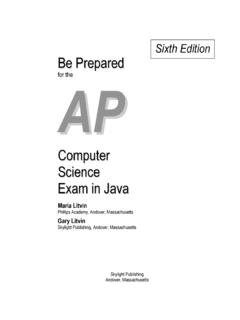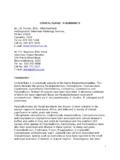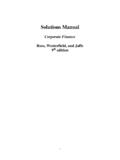Transcription of 2014 AP Exam AB and BC Free-Response Solutions
1 BBee PPrreeppaarreedd for the CCaallccuulluuss EExxaamm Mark Howell Gonzaga High School, Washington, Martha Montgomery Fremont City Schools, Fremont, Ohio Practice exam contributors: Benita Albert Oak Ridge High School, Oak Ridge, Tennessee Thomas Dick Oregon State University Joe Milliet St. Mark's School of Texas, Dallas, Texas Skylight Publishing Andover, Massachusetts Copyright 2005-2014 by Skylight Publishing Chapter 10. Annotated Solutions to Past Free-Response Questions This material is provided to you as a supplement to the book Be Prepared for the AP Calculus Exam. You are not authorized to publish or distribute it in any form without our permission. However, you may print out one copy of this chapter for personal use and for face-to-face teaching for each copy of the Be Prepared book that you own or receive from your school. Skylight Publishing 9 Bartlet Street, Suite 70 Andover, MA 01810 web: e-mail: 3 2014 AB AP Calculus Free-Response Solutions and Notes Question AB-1 (a) The average rate of change is ()()30030 0AA pounds per day.
2 (b) ()15A pounds per day. On day 15, the amount of grass clippings remaining in the bin is decreasing at the rate of pounds per day. (c) The average amount of grass clippings is ()300130 Atdt pounds. 1 Solving () gives days. (d) ()30A and ()30A . 2 () () ()()303030 LtAAt =+ . Solving () gives days. Notes: 1. Store this result in a calculator variable, then use the stored value to solve the equation. 2. Again, store these results in calculator variables (keep greater accuracy to assure that the final answer is correct), then use the stored values in the formula for ()Lt. 4 Free-Response Solutions ~ 2014 AB Question AB-2 (a) Solving ()4fx= gives0x= 1 () ()() =+ + . (b) The area of each isosceles right triangle is ()()2142fx . The volume of the solid is ()() . (c) ()()()() x dxf x dx = . 2 Notes: 1. This is the exact value for the x-coordinate of the point.
3 In this case, it s just as easy to enter in subsequent calculations. 2. Or: ()()()() = . Free-Response Solutions ~ 2014 AB 5 Question AB-3 (a) Using the areas of two triangles, ()()33113541222gftdt == 1 10 1 9= =. 2 (b) The graph of g is increasing where ()()0gx fx = . The graph of g is concave down where ()()0gx fx =<. Both of these conditions hold for 53x < < and for 02x<<. (c) ()()()25525xg xg xhxx = ()()()()()1535315353325 925 9gg fgh === . ()1525 9925 1 13= . (d) ()()()221px f x xx = . The slope at 1x= is equal to () ()()()()123236pf = = =. Notes: 1. You can leave it at that to avoid arithmetic mistakes. 2. Or, using the areas of three triangles, ()11133424129222g= + =. 6 Free-Response Solutions ~ 2014 AB Question AB-4 (a) The average acceleration is the average rate of change of velocity, which is () ()82120 1002208266vv == meters per minute per minute.
4 (b) Since ()Avt is differentiable, it is also continuous. Since 100 is between ()540Av= and ()8120Av= , the Intermediate Value Theorem applied to ()Avt on the interval [5, 8] guarantees that ()100 Avt= for some t between 5 and 8. (c) The position at t = 12 is ()122300 Avtdt+ . Using a trapezoidal sum approximation, this is approximately 100 4040 ( 120)( 120) ( 150)300 (5 2)(8 5)(12 8)222++ + + + + 1 meters. (d) Let ()xt and ()yt be the positions of trains A and B, respectively, and ()zt be the distance between the trains. Then 222zxy=+ 222dzdxdyzxydtdtdt=+ dzdxdyzxydtdtdt=+. At t = 2, ( ) 300xt= and ( )400yt=, so ( ) 500zt=. 2(2) 100 Atdxvdt===. ()256025 Bdyvtttdt== ++, so 225 260 2 25 125tdydt== + + =. Therefore, at t = 2, 500300 100 400 125dzdt= + 2300 100 400 125500tdzdt= + = 2 meters per minute. Notes: 1. 150= , so the train is approximately 150 meters west of Origin Station.
5 2. 160= Free-Response Solutions ~ 2014 AB 7 Question AB-5 (a) f has only one relative minimum on [2,3] , at x = 1, because this is the only number on [2,3] where ()fx changes sign from negative to positive. (b) Since f is a twice-differentiable function, the Mean Value Theorem applies to ()fx on the interval [1,1] . Thus, there is a c in the open interval ()1, 1 such that ()()()1102fffc ==. 1 (c) ()()()fxhxfx = ()()()312133714fhf ===. (d) An antiderivative for ()()()fgxgx is ()()fgx. So ()()()()()()()()()332232f gx gxdx fgxfgfg == = (1)( 1)2 86ff = = . Notes: 1. Alternatively, since (1)(1) 0ff = =, you can refer to Rolle s Theorem. 8 Free-Response Solutions ~ 2014 AB Question AB-6 (a) (b) At (0, 1), the slope is (3 1) cos(0)2 =. An equation of the tangent line is 12yx =. For x = , this gives y = 1 (c) Separating variables, we get ()cos3dyxdxy= ()()cosln 3sin3dyxdxyxCy= =+.
6 Substituting the initial condition (0) 1f=, we get ()()ln 2ln 2CC = = () ()()()ln 3sinln 2ln 3sinln 2yxy x = = + () ()()sinln 2sin32xxyee + ==. Two possible Solutions satisfy this equation, ()sin32xye = and ()sin32xye =+, but only the first one of them satisfies the initial condition (0) 1y=. Therefore, ()sin() 3 2xfxe = . 2 Notes: 1. The statement () is incorrect and could result in lost points. 2. The domain of this solution is all real numbers. 9 2014 BC AP Calculus Free-Response Solutions and Notes Question BC-1 See AB Question 1. Question BC-2 (a) The curves intersect at 2 = and =. The area of R consists of the area in the first quadrant plus the area of the quarter circle in the second quadrant: Area ()()2201932sin224d = + . (b) () ()()()cos3 2 sin 2cosdxdxrdd = = . Therefore, 6dxd = . (c) The distance between the curves as a function of is the difference between their respective values of r for a given , that is, ()()332sin2.
7 The rate of change of that distance is ()()()332sin2dd . At 3 =, the rate of change is 2 . 1 (d) drdr ddtddt = . At 6 =, this is 236 = . Notes: 1. Or write ()()()() ()332sin22 sin2 4cos2dddd ==, which is equal to 2 when 3 =. 10 Free-Response Solutions ~ 2014 BC Question BC-3 See AB Question 3. Question BC-4 See AB Question 4. Question BC-5 (a) Area = ()()221120011121222xxxex dxexe = + = + . 1 (b) Volume = ()()22120222xxexdx + + . (c) Given 2xyxe=, 2222xxdyxeedx=+. The vertical line 1x= intersects 2xyxe= at ye= and intersects 2yx= at 2y= , so the length of the vertical segment is 2e+. The length of the linear segment with slope 2 can be evaluated using the Pythagorean Theorem (or the distance formula): length = 2212 5+=. Perimeter = ()2221202512xxexeedx++ + ++ . Notes: 1. 1122e=+. Free-Response Solutions ~ 2014 BC 11 Question BC-6 (a) ()()()11121211121nnnnnnxannxannx+++ = = ++.
8 ()21lim121 1112nnxxxn = < < + 12R=. (b) The series for f is ()()() ()() xxn+ + + +. The series for f is ()() () ()2112 + + + +. (c) The first term of the series for f is 2 and the common ratio is ()21x , so the series converges to ()()2212 1 2 1fxxx == + ()2ln 2121fxdxxCx== + . ()10f= 0C= ()ln 21fxx= . Since 1322x<<, 21x is positive, so ()()ln 21fxx=.









